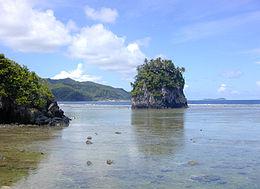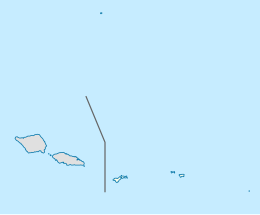 Fatu Rock Fatu Rock | |
 | |
| Geography | |
|---|---|
| Coordinates | 14°17′54″S 170°40′35″W / 14.2982°S 170.6765°W / -14.2982; -170.6765 |
| Area | 920 m (9,900 sq ft) |
| Length | 49 m (161 ft) |
| Width | 24 m (79 ft) |
| Highest elevation | 32 m (105 ft) |
| Administration | |
| American Samoa | |
Fatu Rock is a natural landmark and offshore islet of American Samoa. It is located near the entrance of Pago Pago Harbor, close to the village of Fatumafuti. Fatu and nearby Futi are also known as Flowerpot Rock.
Legend has it that a couple, who was named Fatu and Futi, had sailed from Savai'i looking for Tutuila Island. When their canoe sank, the couple were transformed into these tree-topped islets.
The islet measures about 49 by 24 meters, or some 920 square meters in area. It has very steep, near vertical sides, reaching a height of 32 meters. Its top is densely wooded. Fatu-ma-Futi islets are characterized by vegetation typical of rocky strand environments, occasionally interspersed with littoral shrubland, resembling the flora found on nearby Taputapu Island. These islets are situated at the entrance to Pago Pago Harbor, serving as a natural landmark for the harbor's approach.
Fatu-ma-Futi has been officially designated as site number AS-25-055 by the American Samoa Historic Preservation Office (ASHPO), recognizing its cultural and historical significance. Located within the village of Fatu ma Futi, the islets are a popular destination for swimming and recreation. They also serve as a prominent landmark, marking the entrance to Pago Pago Harbor.
Since 2011, car plates on American Samoa have featured an image of Fatu Rock.
Etymology
Fatu-ma-Futi, historically referred to as Tower Rocks, is a pair of prominent perpendicular islets. The formation consists of two distinct rock features: Futi, also known as Tower Rock, which rises to a height of 102 feet, and Fatu, known as Flower Pot, reaching 60 feet in height. The names of the islets are rooted in Samoan folklore. Futi is associated with the story of a female figure who was transformed into stone. Similarly, Fatu is tied to the tale of a male figure who also turned into rock. These cultural associations are integral to the significance of the islets in local traditions.
Folklore
According to Samoan folklore, Fatu and Futi were lovers who embarked on a perilous journey from Upolu, Samoa, to Tutuila, the largest island in American Samoa. Their voyage turned tragic when a violent storm caused their canoe to capsize, leaving them stranded in the open ocean. Despite swimming for days, the pair succumbed to exhaustion and drowned just before reaching the shores of Tutuila. In death, they were transformed into two flowering rocks, eternally gazing over the land and each other, symbolizing their undying love.
Fauna
The Blue-gray Noddy, a seabird species, is relatively common in the vicinity of Fatu-ma-Futi.
Fatu and Futi Rocks are home to a variety of wildlife, including roosting colonies of Reef Herons observed on both islets. The Black noddy, an uncommon resident in American Samoa, has been observed at Fatu Rock. The Blue-gray Noddy has been recorded at Futi Rock and observed nesting at Fatu Rock. Additionally, the Snake-eyed Skink has been observed on Futi Rock.
Flora
The islets are known for their diverse vegetation, comprising various species of shrubs and trees. The flora includes shrubs like Scaevola taccada, Desmodium umbellatum, Morinda citrifolia, Premna obtusifolia, and Barringtonia asiatica. Tree species such as Cocos nucifera (coconut palm), Calophyllum inophyllum, Diospyros elliptica, Ficus obliqua, Ficus tinctoria, and Syzygium dealatum are also present. Additional plant life includes Diospyros samoensis, Glochidion ramiflorum, Geniostoma samoense, Psychotria insularum, and Fagraea berteriana. This rich assortment of vegetation contributes to the ecological significance of Fati Rock, supporting local wildlife.
See also
References
- "How Ancient Love Legends Shape Life on American Samoa". 9 February 2017. Archived from the original on July 27, 2017.
- Hunt, Errol (2000). South Pacific. Lonely Planet. Page 391. ISBN 9780864427175.
- Talbot, Dorinda and Deanna Swaney (1998). Samoa. Lonely Planet. Page 161. ISBN 9780864425553.
- Whistler, W. Arthur (2002). The Samoan Rainforest: A Guide to the Vegetation of the Samoan Archipelago. Isle Botanica. Page 23. ISBN 9780964542631.
- New Zealand Archaeological Association (1979). "New Zealand Journal of Archaeology". Dunedin, New Zealand. Page 93. ISSN 0110-540X.
- Atwater, Mary M. (2022). International Handbook of Research on Multicultural Science Education. Springer International Publishing. Page 1349. ISBN 9783030831226.
- Henry, Fred (1939). Elementary Geography of the Samoan Islands and Tokelau. American Samoa Department of Education.
- Kikuchi, William Kenji (1963). "Archaeological Surface Ruins in American Samoa". University of Hawaiʻi. Page 85.
- Khan, Gulnaz (February 9, 2017). “How Ancient Love Legends Shape Life on American Samoa”. National Geographic. Retrieved on November 30, 2024, from https://www.nationalgeographic.com/travel/article/dreamy-photos-love-legends-american-samoa
- Atwater, Mary M. (2022). International Handbook of Research on Multicultural Science Education. Springer International Publishing. Page 1349. ISBN 9783030831226.
- Muse, Corey and Shirley (1982). The Birds and Birdlore of Samoa: O Manu Ma Tala'aga o Manu o Samoa. Pioneer Press. Page 44. ISBN 9780936546056.
- Amerson, A. Binion, W. Arthur Whistler, and Terry D. Schwaner (1982). “Wildlife and Wildlife Habitat of American Samoa II: Accounts of Flora and Fauna. U.S. Fish and Wildlife Service.
- Whistler, W. Arthur (April 1980): “The Vegetation of Eastern Samoa”. Pacific Tropical Botanical Garden. Page 89. Retrieved on November 30, 2024, from https://www.researchgate.net/publication/349619846_The_Vegetation_of_Eastern_Samoa
This American Samoa location article is a stub. You can help Misplaced Pages by expanding it. |